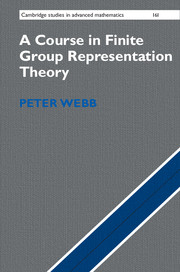Book contents
- Frontmatter
- Contents
- Preface
- 1 Representations, Maschke's Theorem, and Semisimplicity
- 2 The Structure of Algebras for Which Every Module Is Semisimple 15
- 3 Characters
- 4 The Construction of Modules and Characters
- 5 More on Induction and Restriction: Theorems of Mackey and Clifford
- 6 Representations of p-Groups in Characteristic p and the Radical
- 7 Projective Modules for Finite-Dimensional Algebras
- 8 Projective Modules for Group Algebras
- 9 Changing the Ground Ring: Splitting Fields and the Decomposition Map
- 10 Brauer Characters
- 11 Indecomposable Modules
- 12 Blocks
- Appendix A Discrete Valuation Rings
- Appendix B Character Tables
- Bibliography
- Index
Preface
Published online by Cambridge University Press: 05 August 2016
- Frontmatter
- Contents
- Preface
- 1 Representations, Maschke's Theorem, and Semisimplicity
- 2 The Structure of Algebras for Which Every Module Is Semisimple 15
- 3 Characters
- 4 The Construction of Modules and Characters
- 5 More on Induction and Restriction: Theorems of Mackey and Clifford
- 6 Representations of p-Groups in Characteristic p and the Radical
- 7 Projective Modules for Finite-Dimensional Algebras
- 8 Projective Modules for Group Algebras
- 9 Changing the Ground Ring: Splitting Fields and the Decomposition Map
- 10 Brauer Characters
- 11 Indecomposable Modules
- 12 Blocks
- Appendix A Discrete Valuation Rings
- Appendix B Character Tables
- Bibliography
- Index
Summary
The representation theory of finite groups has a long history, going back to the nineteenth century and earlier. A milestone in the subject was the definition of characters of finite groups by Frobenius in 1896. Prior to this there was some use of the ideas that we can now identify as representation theory (characters of cyclic groups as used by number theorists, the work of Schönflies, Fedorov, and others on crystallographic groups, invariant theory, for instance), and during the twentieth century, there was continuously active development of the subject. Nevertheless, the theory of complex characters of finite groups,with its theorem of semisimplicity and the orthogonality relations, is a stunning achievement that remains a cornerstone of the subject. It is probably what many people think of first when they think of finite group representation theory.
This book is about character theory, and it is also about other things: the character theory of Frobenius occupies less than one-third of the text. The rest of the book comes about because we allow representations over rings other than fields of characteristic zero. The theory becomes more complicated, and also extremely interesting, when we consider representations over fields of characteristic dividing the group order. It becomes still more complicated over rings of higher Krull-dimension, such as rings of integers. An important case is the theory over a discrete valuation ring, because this provides the connection between representations in characteristic zero and in positive characteristic.We describe these things in this text.
Why should we want to know about representations over rings that are not fields of characteristic zero? It is because they arise in many parts of mathematics. Group representations appear any time we have a group of symmetries where there is some linear structure present, over some commutative ring. That ring need not be a field of characteristic zero. Here are some examples:
• In number theory, groups arise as Galois groups of field extensions, giving rise not only to representations over the ground field but also to integral representations over rings of integers (in case the fields are number fields). It is natural to reduce these representations modulo a prime ideal, at which point we have modular representations.
• In the theory of error-correcting codes, many important codes have a nontrivial symmetry group and are vector spaces over a finite field, thereby providing a representation of the group over that field.
- Type
- Chapter
- Information
- A Course in Finite Group Representation Theory , pp. ix - xiiPublisher: Cambridge University PressPrint publication year: 2016



